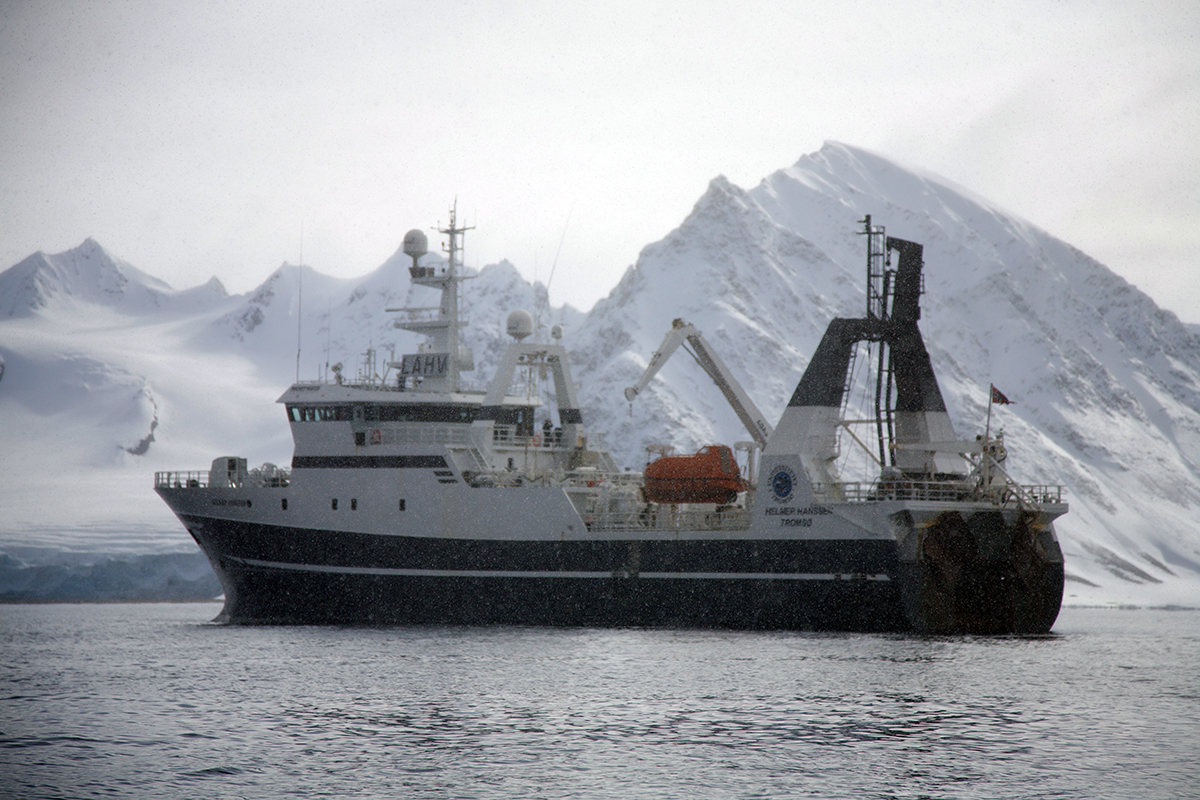In a growing population scenario mesopelagic species may prove to be a new food resource and lead to innovative product development. The cruise collected data that may provide knowledge about mesozooplankton and mesopelagic predators in the northern Norwegian Sea.
Research vessel Helmer Hanssen left at the end of May from Tromsø and surveyed transect lines to the west from the Norwegian shelf into the open ocean. Researchers from Sintef Ocean and Uit Arctic University of Norway worked in partnership to cover different activities in relation to plankton communities, fishing gear technology and marine ingredients processing. The cruise collected data down to 1200m depth that will provide information to enable mesozooplankton mass estimation and characterization. The water column was also profiled at different depths for data regarding environmental variables. Testing new technologies for identifying and harvesting aggregations of selected mesopelagic species was also part of the cruise research. Besides, preservation and processing methods were applied to optimize the stability and quality of new biomarine ingredients from low trophic marine species.

Tales from the depths
The so-called mesopelagic zone is a dark oceanic habitat that extends from 200 to 1000 metres depths. Known as the “twilight zone”, 1% of the sunlight reaches the top of this area whereas no light is found by the bottom. For many decades, the presence of bizarre and bioluminescence creatures has attracted the attention of many researchers who have tried to discover what is hidden in the deep sea. These species play an important role in marine food web interactions, being one of the principal components transferring nutrients from low trophic levels to larger pelagic predators. Furthermore, its contribution is crucial for the regulation of climate by carbon cycling. But overall, the current knowledge on mesopelagic species remains yet quite unknown within marine science research.
Since the 1970’s, different investigations have emphasized the potential of mesopelagic species as one of the largest and yet unexploited marine resources. Current estimations suggest a total fish biomass that ranges between 1000 and 10,000 tonnes. In this context, within a growing population scenario, mesopelagic species have been targeted for the development of a potential new fishery that could provide new sources of food, dietary supplements, fishmeal and nutraceuticals. However, research is needed in terms of ecology, biology, harvesting and processing to prevent any kind of consequences to the ecosystem and thus develop a knowledge-based management for a sustainable exploitation.

Future perspectives
Increased attention on mesopelagic resources has led to several commercial and research trials for biomass and scientific assessment. Despite the efforts, empirical results revealed major knowledge gaps in, among others, stock assessment, distribution, seasonal variability and species composition. At this point, biology, ecology and technology need to meet in order to develop innovative harvesting and processing technologies for the development of a profitable new biomarine industry.

Despite the scenario, researchers at Helmer Hanssen put their effort for 15 days to get relevant data that may contribute filling these gaps. These cruises allow the interaction between different groups and, therefore, the synergy of results that contribute throughout the different steps of the value chain. Understanding the ecological functioning of the mesopelagic species and the environmental variables by which they are influenced will help to understand their behaviour and spatial temporal distribution. This can lead to the development of models to predict the distribution of stocks and therefore optimize the fishing and harvesting process. The use of the appropriate fishing gear technology contributes on reduced by-catch hauls, which allows a better processing and thus guarantees a higher quality and stability of the raw material. All these efforts share a holistic approach to ensure a sustainable management and harvesting of a potential new fishery based on mesopelagic species. This cruise will be repeated yearly in order to evaluate and predict ecosystem dynamics.

0 comments on “Research cruise Helmer Hanssen investigates potential of twilight zone:”